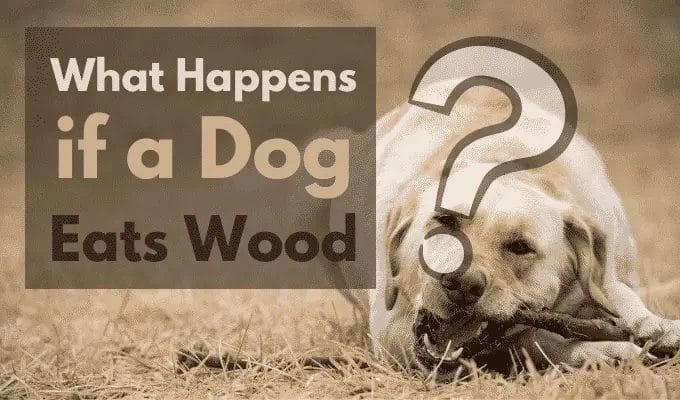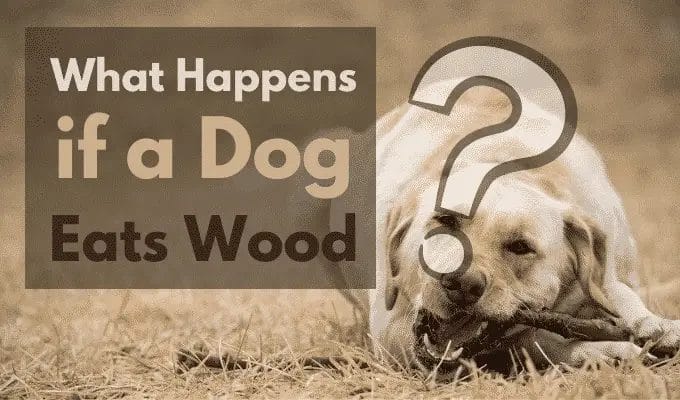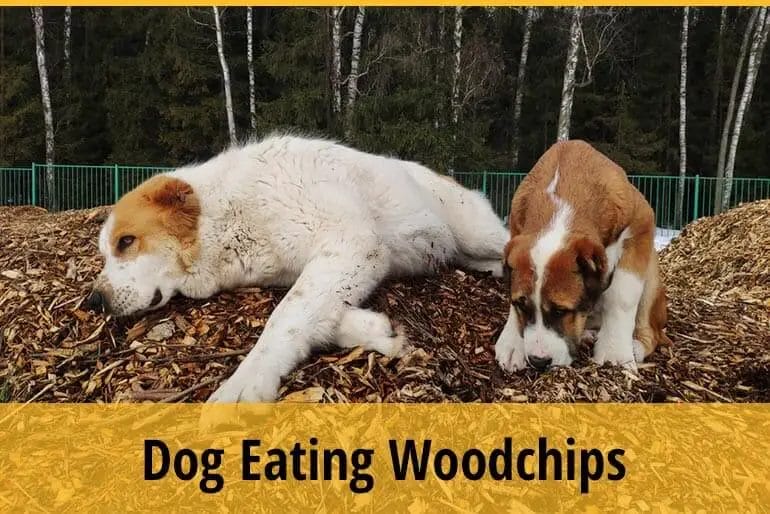If your dog eats wood, it can be concerning and potentially dangerous. Wood can cause several issues, including intestinal blockages, splintering, and choking hazards. Ingesting large pieces of wood can lead to serious health problems, such as punctured organs or internal bleeding. It is important to monitor your dog’s behavior and contact a veterinarian if you suspect they have consumed wood. Taking preventive measures, such as keeping your dog’s environment free of wooden objects and providing appropriate chew toys, can help minimize the risk of wood ingestion.

Potential Risks and Dangers: Exploring the consequences of a dog eating wood
Many dog owners have experienced the frustration of their furry friend devouring the furniture or chewing on random objects. One common and potentially dangerous behavior is when dogs eat wood. While it may seem harmless at first, there are several risks and dangers associated with this habit that every dog owner should be aware of.

1. Choking Hazard
One of the immediate dangers of a dog eating wood is the risk of choking. Wood can splinter easily, especially when chewed vigorously, and these splinters can get lodged in your dog’s throat or digestive tract. This can lead to life-threatening situations where your dog may struggle to breathe or experience severe pain. If you notice your dog eating wood, it is crucial to intervene immediately and seek veterinary assistance if necessary.
2. Intestinal Blockage
Wood is not easily digestible for dogs, and ingesting large pieces can result in intestinal blockages. This occurs when chunks of wood become trapped in the digestive system, preventing the normal flow of food and waste. Symptoms of an intestinal blockage include vomiting, diarrhea, abdominal pain, and loss of appetite. If left untreated, an intestinal blockage can be fatal and may require surgery to remove the obstructed wood.
3. Dental Damage
Chewing on hard objects like wood can cause significant dental damage to your dog’s teeth. Splintered wood or sharp edges can break or fracture teeth, leading to pain, infection, and difficulty eating. It is important to regularly examine your dog’s mouth for any signs of dental issues and consult with a veterinarian if you suspect any damage.
4. Toxicity
Not all types of wood are safe for dogs to consume. Certain types, such as treated or painted wood, can contain toxic substances like chemicals or lead-based paint. Ingesting these toxic materials can have severe health consequences for your dog, including nausea, vomiting, diarrhea, and even organ damage. If you suspect your dog has ingested toxic wood, contact your veterinarian immediately.
5. Behavioral Issues
Repeatedly eating wood can also indicate underlying behavioral issues in dogs. It may be a sign of anxiety, boredom, or a lack of proper mental stimulation. If your dog is consistently engaging in this behavior, it is essential to address the root cause and provide appropriate outlets for their energy and mental stimulation.
6. Accidental Ingestion of Other Objects
In addition to the dangers of wood itself, dogs who develop a habit of eating wood may also inadvertently ingest other objects hidden within or around the wood. This includes nails, screws, or other small items that can pose additional risks, such as internal injuries or infections.
In summary, while it may be tempting to dismiss a dog eating wood as a quirky behavior, it is crucial to recognize the potential risks and dangers associated with this habit. From choking hazards and intestinal blockages to dental damage and toxic exposure, the consequences can be severe. It is essential for dog owners to provide proper supervision, training, and environmental enrichment to prevent their furry companions from engaging in this potentially harmful behavior.
Symptoms and Signs to Watch Out For: Identifying the signs that indicate a dog has ingested wood
As responsible pet owners, it is important for us to be vigilant and on the lookout for any unusual behavior or signs of distress in our furry friends. Dogs, being naturally curious creatures, can sometimes get themselves into trouble by ingesting objects that are not safe for them. One such object is wood, which can pose serious health risks if ingested by dogs. In this section, we will discuss the symptoms and signs to watch out for that may indicate a dog has ingested wood.
1. Behavioral Changes:
One of the first indicators that a dog may have ingested wood is a sudden change in behavior. Pay attention to any unusual restlessness, anxiety, or irritability displayed by your dog. They may seem uncomfortable and constantly try to find a place to rest or lie down.
2. Vomiting and/or Diarrhea:
If your dog has ingested wood, they may experience digestive upset, resulting in vomiting and/or diarrhea. Keep an eye out for any sudden bouts of vomiting or loose stools. These symptoms can be alarming and may indicate that your dog’s body is trying to expel the foreign object.
3. Loss of Appetite:
An unwillingness to eat or a significant decrease in appetite can also be a sign that your dog has ingested wood. The foreign object may cause discomfort or pain in the digestive tract, leading to a loss of interest in food. If your dog consistently refuses meals or shows a lack of interest in their favorite treats, it is essential to consult a veterinarian.
4. Abdominal Pain:
Dogs that have ingested wood may experience abdominal pain or discomfort. Watch out for any signs of tenderness or sensitivity when you touch their abdomen. They may show signs of distress by whining, whimpering, or avoiding any pressure on their stomach area.
5. Coughing or Choking:
Wood splinters or fragments can get lodged in a dog’s throat, causing coughing or choking episodes. If you notice your dog repeatedly coughing or gagging, it could be a sign that they have swallowed wood. Prompt veterinary attention is crucial in such cases to prevent further complications.
6. Lethargy and Weakness:
When a dog ingests wood, it may lead to an overall feeling of lethargy and weakness. They may seem tired, have difficulty moving around, or display a lack of energy. This could be due to the body’s efforts to combat the foreign object and the resulting discomfort or inflammation.
7. Difficulty Defecating:
If a dog has ingested a large piece of wood, it can cause a blockage in their digestive system. This blockage can make it difficult for them to pass stool, leading to straining, discomfort, and in severe cases, constipation. Keep an eye on your dog’s bowel movements and consult a veterinarian if you notice any abnormalities.
8. Blood in Stool:
In some cases, ingesting wood can cause injuries or tears in the digestive tract, leading to the presence of blood in the stool. If you notice any traces of blood in your dog’s feces, it is essential to seek immediate veterinary attention as it may indicate internal bleeding or other serious complications.
In summary, being able to identify the symptoms and signs that indicate a dog has ingested wood is crucial for their well-being. If you notice any of the aforementioned signs in your dog, it is important to consult a veterinarian promptly. Early detection and treatment can help prevent further complications and ensure the best possible care for your beloved furry companion.
Treatment Options for Wood Ingestion
Wood ingestion is a common issue among dogs, especially those with a tendency to chew or explore their surroundings using their mouths. While it may seem harmless, ingesting wood can lead to various health complications, including intestinal blockage and splinter injuries. As a responsible dog owner, it is essential to address this issue promptly and provide appropriate treatment options to help your furry friend recover. In this section, we will explore effective treatment options for wood ingestion in dogs.
1. Monitor your dog
After noticing that your dog has ingested wood, the first step is to closely monitor their behavior and symptoms. Keep a close eye on any changes in their appetite, bowel movements, and overall demeanor. If your dog shows signs of distress or discomfort, such as vomiting, diarrhea, or abdominal pain, it is crucial to seek veterinary assistance immediately.
2. Contact your veterinarian
When dealing with wood ingestion, it is always advisable to consult your veterinarian. They can provide professional guidance and assess the severity of the situation. Based on the specific circumstances and your dog’s health condition, your veterinarian may recommend one or a combination of the following treatment options.
3. Inducing vomiting
In some cases, if the ingestion has occurred recently and the wood has not passed into the intestines, your veterinarian may induce vomiting to remove the ingested material. This procedure should only be performed under the supervision of a professional, as it can carry risks if not done correctly or in specific situations.
4. Endoscopy
Endoscopy is another treatment option that can be used to remove wood fragments from your dog’s digestive system. This minimally invasive procedure involves passing a flexible tube with a camera attached to it through the mouth or rectum. The veterinarian can visualize the gastrointestinal tract and remove any wood pieces using specialized tools.
5. Surgery
In severe cases where the wood has caused intestinal blockage or there is a high risk of complications, surgical intervention may be necessary. Surgery aims to remove the ingested wood and repair any damage caused to the digestive tract. This option is typically considered when other methods have been unsuccessful or when the condition is critical.
6. Symptomatic treatment
Depending on your dog’s symptoms and overall health, your veterinarian may prescribe medications to alleviate discomfort and manage any secondary issues caused by wood ingestion. These may include anti-inflammatory drugs to reduce swelling, antibiotics to prevent infection, and medications to support gastrointestinal function.
7. Preventive measures
While treatment options are essential, it is equally important to take preventive measures to avoid wood ingestion in the first place. Some strategies to consider include:
- Supervising your dog during outdoor activities and discouraging them from chewing on wood or picking up sticks.
- Providing appropriate chew toys and engaging in regular play sessions to redirect their chewing behavior.
- Training your dog to have a strong “leave it” or “drop it” command to prevent them from picking up or ingesting wood.
- Ensuring your dog’s environment is free from any potential wood hazards, such as splintered fences or furniture.
By implementing these preventive measures, you can significantly reduce the risk of wood ingestion and potential health complications for your beloved canine companion.
Summary
Wood ingestion in dogs can lead to various health issues, and it is crucial to address the problem promptly. Treatment options may include monitoring your dog, contacting your veterinarian, inducing vomiting, endoscopy, surgery, and symptomatic treatment. Additionally, implementing preventive measures can help minimize the risk of wood ingestion in the future. Remember, always consult your veterinarian for accurate diagnosis and guidance tailored to your dog’s specific needs.
Preventing Wood Consumption: Tips and strategies to stop dogs from eating wood
Dogs are curious creatures and they love to explore their surroundings. However, if your furry friend has developed a habit of eating wood, it can be a cause for concern. Not only can this behavior be destructive to your property, but it can also pose a serious health risk to your dog. In this section, we will discuss some tips and strategies to prevent dogs from consuming wood.1. Provide Sufficient Exercise and Mental Stimulation
One of the main reasons dogs engage in destructive behaviors like chewing on wood is due to boredom or pent-up energy. Ensuring that your dog gets enough exercise and mental stimulation can help redirect their focus away from chewing on wood. Take your dog for regular walks, engage in play sessions, and provide them with interactive toys to keep them occupied.2. Use Bitter Apple Spray or Anti-Chew Deterrents
Bitter apple spray is a safe and effective deterrent that can be sprayed on wood surfaces to discourage dogs from chewing. The taste is unpleasant for dogs, and they will learn to associate the taste with wood, eventually deterring them from chewing on it. Additionally, there are anti-chew deterrents available in pet stores that can be applied to wood surfaces to discourage chewing.3. Keep Your Dog’s Mouth Occupied
Provide your dog with appropriate chew toys to keep their mouth occupied. By offering an alternative to chew on, you can redirect their attention away from wood. Choose durable chew toys made specifically for dogs, and monitor your dog while they chew to ensure they are not swallowing any small or dangerous parts.4. Utilize Positive Reinforcement Training
Positive reinforcement training can be highly effective in modifying your dog’s behavior. Whenever you catch your dog avoiding wood or engaging in appropriate behavior, reward them with praise or treats. This will reinforce the desired behavior and encourage them to continue making the right choices.5. Remove Access to Wood
Prevention is key when it comes to stopping dogs from eating wood. If possible, remove access to wood or block off areas where your dog has been chewing. Use baby gates or create barriers to restrict their access to wooden objects. This will help break the habit and prevent further destruction.6. Consult a Professional
If your dog’s wood consumption behavior persists or becomes excessive, it is advisable to consult a professional dog trainer or behaviorist. They can assess the underlying reasons for the behavior and provide tailored solutions to address the issue. In summary, preventing dogs from consuming wood requires a combination of strategies. Providing sufficient exercise and mental stimulation, using deterrent sprays, keeping your dog’s mouth occupied with chew toys, utilizing positive reinforcement training, removing access to wood, and seeking professional help when necessary can all contribute to curbing this destructive behavior. By implementing these tips and strategies, you can ensure the safety of your dog and protect your property from unnecessary damage.Understanding the Underlying Causes: Exploring why dogs may have a tendency to eat wood
Wood-eating behavior, also known as pica, is not uncommon among dogs. This behavior can be puzzling and concerning for pet owners, as it may pose potential risks to the dog’s health. In order to address this issue effectively, it is important to delve deeper into the underlying causes of why dogs may have a tendency to eat wood.
1. Nutritional Deficiencies: One possible reason for a dog’s wood-eating behavior is nutritional deficiencies. When a dog’s diet lacks certain essential nutrients, they may be compelled to seek out alternative sources to compensate for these deficiencies. Wood, in some cases, may provide a source of fiber or other nutrients that dogs are lacking.
2. Boredom and Lack of Mental Stimulation: Dogs are intelligent animals that require mental stimulation to prevent boredom. When dogs are left alone for extended periods of time without proper mental and physical exercise, they may resort to engaging in destructive behaviors, such as wood chewing. It serves as a form of entertainment and an outlet for their excess energy.
3. Attention-seeking Behavior: Dogs are social creatures and crave attention from their owners. If a dog feels neglected or lacks appropriate interaction, they may resort to engaging in attention-seeking behaviors, such as chewing on wood. This behavior often elicits a reaction from their owners, even if it is negative attention, which reinforces the behavior.
4. Teething and Oral Discomfort: Puppies, in particular, may exhibit wood-eating behavior during their teething phase. Chewing on objects, including wood, can provide relief to their sore gums. However, if this behavior persists beyond the teething stage, it may be indicative of an underlying dental or oral health issue.
5. Anxiety and Stress: Dogs, like humans, can experience anxiety and stress. Stressors such as changes in their environment, separation anxiety, or fear can trigger destructive behaviors, including wood chewing. This behavior can serve as a coping mechanism for the dog to alleviate their anxiety or frustration.
6. Learned Behavior: Dogs are observant animals and can learn from their surroundings. If a dog sees other dogs or animals chewing on wood, they may imitate this behavior. Additionally, if a dog receives reinforcement, such as attention or treats, while engaging in wood-eating behavior, they are more likely to continue the behavior in the future.
It is important to note that wood-eating behavior can pose risks to a dog’s health. Wood splinters can cause injury or blockages in the digestive system, leading to serious complications. Therefore, it is essential to address this behavior in a timely manner and take appropriate measures to prevent it.
In summary, understanding the underlying causes of why dogs may have a tendency to eat wood can help pet owners address this behavior effectively. By ensuring that their nutritional needs are met, providing adequate mental and physical stimulation, addressing any underlying anxiety or stress, and discouraging the behavior through positive reinforcement training, pet owners can help their dogs break the habit of wood-eating and promote a healthier and safer environment for their furry friends.

FAQs
What happens if a dog eats wood?
If a dog eats wood, it can pose serious health risks. Splinters can cause internal injuries or blockages in the digestive system. Wood may also contain harmful chemicals or be treated with toxic substances. Symptoms may include vomiting, diarrhea, abdominal pain, and decreased appetite. It’s important to seek veterinary care if your dog has ingested wood.
Conclusion
In conclusion, it is important to be aware of the potential dangers when a dog eats wood. The ingestion of wood can lead to a range of health issues for dogs, including choking hazards, digestive blockages, and splinters causing internal damage. If your dog has ingested wood, it is crucial to monitor their behavior and look out for signs of distress or discomfort.
Seeking veterinary assistance is recommended to ensure the well-being of your furry friend. Additionally, providing appropriate chew toys and mental stimulation can help redirect your dog’s chewing behavior and prevent them from consuming wood in the first place.
